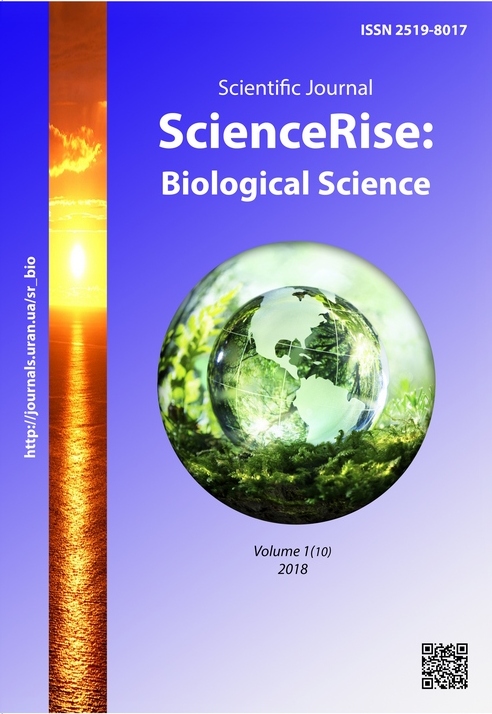The nature of the spread of porcine circovirus type 2 as an emerging in Ukraine during the period from 2007 to 2012
DOI:
https://doi.org/10.15587/2519-8025.2018.124837Keywords:
swine infection, Porcine circovirus 2 (PCV-2), porcine multisystemic wasting syndrome, PCRAbstract
Pathogenic Porcine circovirus 2 (PCV-2) is a causal agent of many PCV‑2‑assocciated diseases of pigs, including porcine multisystemic wasting syndrome. Those diseases have a harmful effect by pigs’ production. Also, hotbeds of this infection are providing wide spread of this virus around the world. Ukraine is one of «hotspot» for PCV‑2‑assocciated infection, but has not enough information about distribution of this virus. Therefore, we have conducted a study to identify the causative agent of the mentioned disease. This article summarizes the results obtained by studying pathological material during the period from 2007 to 2012 by molecular diagnostics (PCR). Our results show that the distribution area for PCV-2 in Ukraine is mostly Ternopil’ (80 %), Kirovograd (60 %), Vinnitsa (57 %), and Dnipropetrovs’k (52 %) regions. It is less common in Kharkov (35 %), Cherkassy and Zaporizhya (both 27 %), and Lviv (33 %) regions. Nevertheless, some regions – like Zhitomir, Ivano-Frankivsk and Luhansk regions and Volyn’ – require a detailed study on the spread of the PCV-2
References
- Tischer, I., Mields, W., Wolff, D., Vagt, M., Griem, W. (1986). Studies on epidemiology and pathogenicity of porcine circovirus. Archives of Virology, 91 (3-4), 271–276. doi: 10.1007/bf01314286
- Hamel, A. L., Lin, L. L., Nayar, G. P. (1998). Nucleotide Sequence of Porcine Circovirus Associated with Postweaning Multisystemic Wasting Syndrome in Pigs. Journal of Virology, 72 (6), 5262–5267.
- Morozov, I., Sirinarumitr, T., Sorden, S. D., Halbur, P. G., Morgan, M. K., Yoon, K-J., Paul, P. S. (1998). Detection of a Novel Strain of Porcine Circovirus in Pigs with Postweaning Multisystemic Wasting Syndrome. Journal of Clinical Microbiology, 36 (9), 2535–2541
- Segales, J., Allan, G. M., Domingo, M. (2005). Porcine circovirus diseases. Animal Health Research Reviews, 6 (2), 119–142. doi: 10.1079/ahr2005106
- Patterson, A. R., Opriessnig, T. (2010). Epidemiology and horizontal transmission of porcine circovirus type 2 (PCV2). Animal Health Research Reviews, 11 (2), 217–234. doi: 10.1017/s1466252310000162
- Rose, N., Opriessnig, T., Grasland, B., Jestin, A. (2012). Epidemiology and transmission of porcine circovirus type 2 (PCV2). Virus Research, 164 (1-2), 78–89. doi: 10.1016/j.virusres.2011.12.002
- Timmusk, S., Wallgren, P., Brunborg, I. M., Wikstrom, F. H., Allan, G., Meehan, B. et. al. (2008). Phylogenetic analysis of porcine circovirus type 2 (PCV2) pre- and post-epizootic postweaning multisystemic wasting syndrome (PMWS). Virus Genes, 36 (3), 509–520. doi: 10.1007/s11262-008-0217-1
- Guo, L. J., Lu, Y. H., Wei, Y. W., Huang, L. P., Liu, C. M. (2010). Porcine circovirus type 2 (PCV2): genetic variation and newly emerging genotypes in China. Virology Journal, 7 (1), 273–285. doi: 10.1186/1743-422x-7-273
- Kim, H. K., Luo, Y., Moon, H. J., Park, S. J., Keum, H. O., Rho, S., Park, B. K. (2009). Phylogenetic and recombination analysis of genomic sequences of PCV2 isolated in Korea. Virus Genes, 39 (3), 352–358. doi: 10.1007/s11262-009-0395-5
- Franzo, G., Tucciarone, C. M., Cecchinato, M., Drigo, M. (2016). Porcine circovirus type 2 (PCV2) evolution before and after the vaccination introduction: A large scale epidemiological study. Scientific Reports, 6 (1). doi: 10.1038/srep39458
Downloads
Published
How to Cite
Issue
Section
License
Copyright (c) 2018 Lyudmila Dudar, Valery Polischuk, Iryna Sobko, Iryna Budzanivska

This work is licensed under a Creative Commons Attribution 4.0 International License.
Our journal abides by the Creative Commons CC BY copyright rights and permissions for open access journals.
Authors, who are published in this journal, agree to the following conditions:
1. The authors reserve the right to authorship of the work and pass the first publication right of this work to the journal under the terms of a Creative Commons CC BY, which allows others to freely distribute the published research with the obligatory reference to the authors of the original work and the first publication of the work in this journal.
2. The authors have the right to conclude separate supplement agreements that relate to non-exclusive work distribution in the form in which it has been published by the journal (for example, to upload the work to the online storage of the journal or publish it as part of a monograph), provided that the reference to the first publication of the work in this journal is included.









